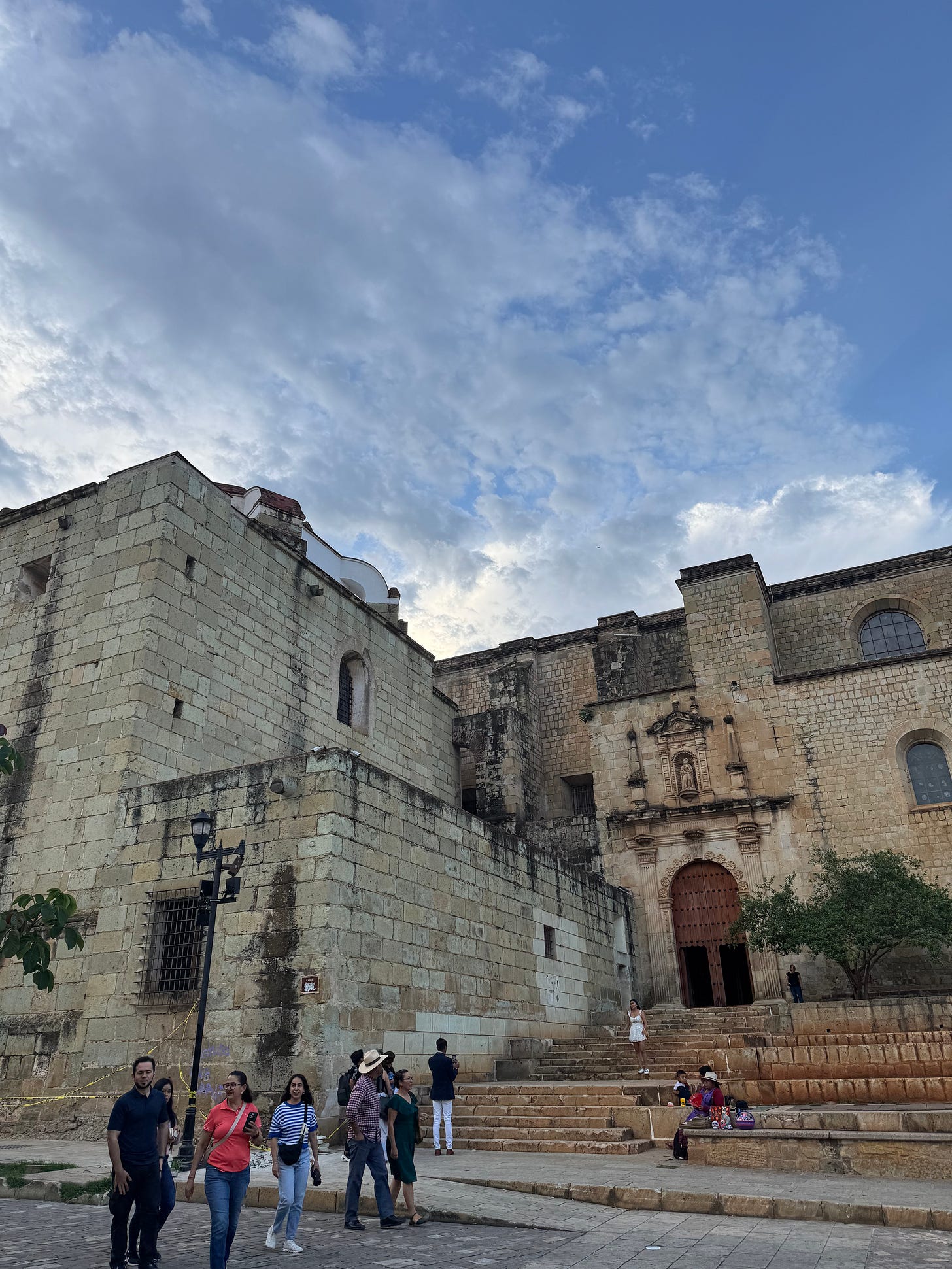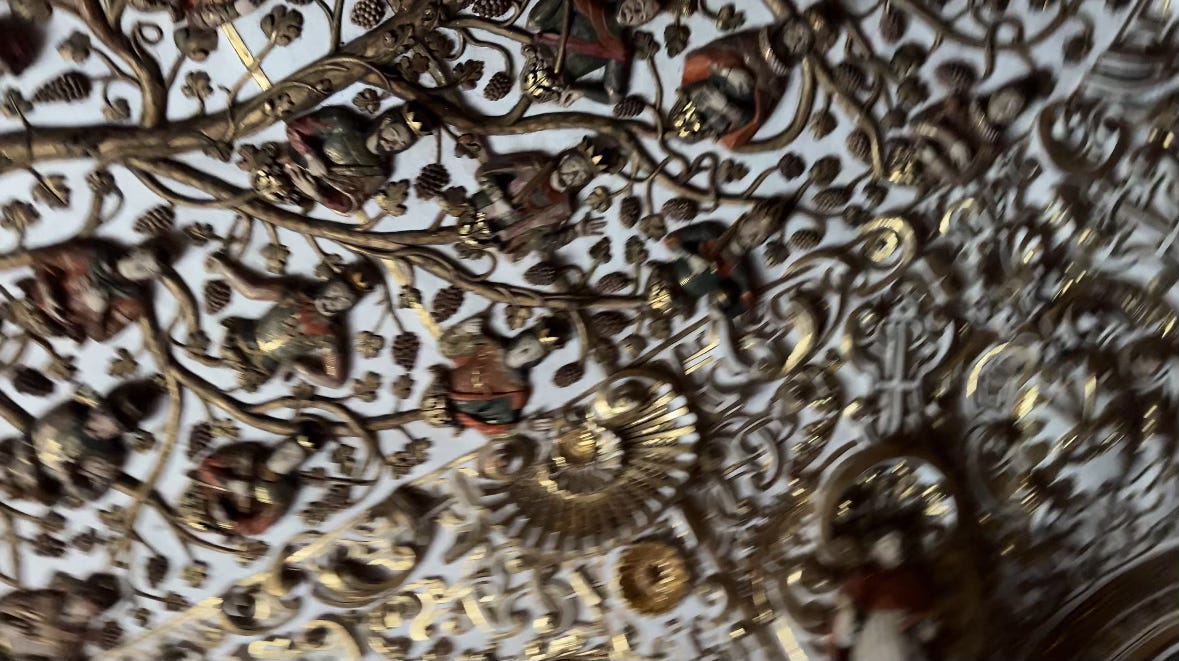Father Iglesia walked down the alley past half-made flotillas and their operators. The air was thick with chorizo meat smoke and sweet bread. Everyone was putting final touches together in preparation for the first night’s celebration of Dia De Los Muertos in just a few hours. There in the botanical garden behind the cathedral were the church’s own flotillas, two giant clouds painted with the faces of the saints, which when viewed from afar looked like a pair of all-knowing eyes.
“These will be tethered to the cathedral above the altar,” Iglesia explained when he first presented the plans. “We will need to drill into the rock, but these will be a symbol every year that Christ is coming in the clouds, and reigns over Los Muertos.”
Now, as Iglesia walked past the clouds and through the garden, he nodded to the group of attendants that would hoist them later. He slipped through the back door to the cathedral and went straight to the sacristy, dropping his duffel and changing rapidly. Kneeling one last time, he clutched a wooden rosary and looked to the fluorescent lights above him.
“Ultima dia,” He whispered, and walked out to get ready for mass.
The church was filling with the faithful, kneeling and muttering, and in each pew there were one or two with skull facepaint, ready to greet the imminent festivities as soon as the crowd would stream from their ritual that is the centerpiece of Oaxaca, just as it is of thousands of cities around the world. The organist filled the arching ceiling with dour, severe gusts, trembling the dead in their pews below, shaking even the pillars holding up the roof above them, such that the reliefs of Mary, her blessed Son, and the dozens of inspired mendicants seemed to wrench themselves from their painted prisons and threaten to descend on the Mass. To keep from blowing out the back door, some attendants cowered from the organ, but most kept their eyes on the solid gold altar, which thrummed and gloated in terror.
Father Iglesia neared the Eucharist, and as the organist breathed fire from heaven on the quaking and shuddering attendants, Iglesia glanced to the gold-painted straps around the altar and up to the translucent wires tracing from the organ to unnoticeable newly-drilled holes in the ceiling and walls. Regarding the image of Christ at the center of the altar, Iglesia held the bread and the cup aloft, the Body and Blood of Christ, and the Mass behind him looked on in fear. He could hear helicopters, but only because he was listening for them, because for the rest, the organist continued to command mind body and soul with his wrath.
“It’s not real.” Iglesia thought to himself, and spun a little too quickly, spilling a bit of the wine as he showed it to the crowd. The organist paused and into the death-knell silence, Iglesia roared:
“Your old gods will deliver you from our sins!”
And at that moment, the organist leaned into the keys, so low and blasphemously dark that he might’ve produced the sound of the sky rending, and he did, because just as he bled this ghastly chord, the explosives that were wired to the ceiling set off, and the entire back wall of the church where the altar stood broke cleanly from the cathedral, and as the evening light streamed in to glance off of the golden altar and blind the crowd, they could see that the altar was being hoisted away by two helicopters each in the shape of the Aztec feathered-serpent god Quetzalcoatl, which upon ignition had ripped through the rubber cloud façade that hid them from plain view. As the thin, snaking helicopters rose above Oaxaca, the altar swung like the golden jaw of Tezcatlipoca the jaguar god, ripped from the skull of the church by the hinge and shimmering and glinting impossibly in the evening hour. Below in the church, Iglesia threw off his Catholic robes to reveal red, orange, green, and blue vestments, for he represented Huitzilopochtli, the god of the sun, and the Mass melted away in shock and terror. And as the altar was raised higher and the helicopters further apart from each other, a cargo plane painted like the skull of Xolotl, the canine guide to the underworld, flew above the altar and between the two long straps connecting the altar to the helicopters. Xolotl let out a net below that wrapped around the altar, and as the winch connecting the net to the cargo plane became taught and the alter was drawn into the gaping mouth of Xolotl, the helicopters released their tethers and flew into the blinding sun in its golden hour, Quetzalcoatl returning to Huitzilopochtli. For inside of the cargo plane was another beast, perhaps a manifestation of Xolotl himself, a grinding set of gears and jaws to rival the seismic mantle of the earth. The wench pulled the solid golden altar into the jaws of Xolotl, and hundreds of feet below, as the thousands gathered to celebrate the Day of the Dead looked to the skies in shock and bewilderment, Xolotl blotted out the sun with a cloud of fine gold dust that settled in the streets of Oaxaca and covered the heads and shoulders, the chests and arms of the citizens dancing in the gold mist cloud.






